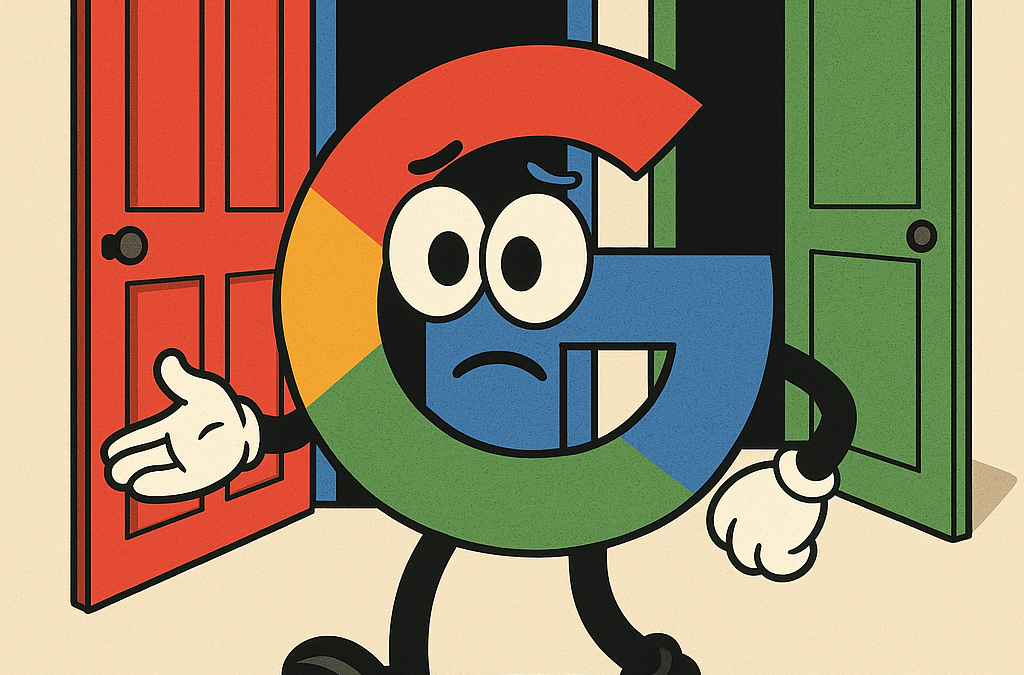Originally published: May 29, 2013 – Updated April 1, 2025
In the ever-evolving world of search engine optimization, one principle has remained unchanged: attempts to deceive search engines will eventually backfire. Doorway pages—also called gateway, bridge, jump, or entry pages—are a textbook example of black-hat SEO. They’re designed not for users, but to manipulate search rankings. As of Google’s March 2024 Core Update and the 2025 SEO landscape, these tactics are more detectable and more penalized than ever.
What Are Doorway (Gateway) Pages?
According to Google’s official guidelines on spam, doorway pages are:
“Sites or pages created to rank for specific, similar search queries. They lead users to intermediate pages that are not as useful as the final destination.”
In plain terms, doorway pages are thin content pages loaded with keywords meant to rank in search engines—but once you click, you’re redirected to another page (usually one not optimized for that search term). These pages do not offer unique value, satisfy search intent, or serve the user. Their goal is ranking, not relevance.
Expert Breakdown: Why Doorway Pages Are Harmful
1. They Dilute User Experience (UX)
From Google’s own guidance: “We want to rank pages that are useful to users.” Doorway pages inherently offer low value because they interrupt the user’s journey. A page that doesn’t provide immediate, relevant content increases bounce rate and decreases dwell time—both negative engagement signals.
2. They Fragment Authority and Link Equity
When you create dozens (or hundreds) of similar pages targeting slight keyword variations (e.g., “Plumber in Toronto,” “Plumber in North York,” “Plumber in Etobicoke”) without unique, localized content, you’re spreading your authority too thin. Instead of consolidating relevance and backlinks to a strong page, you’re creating shallow satellite pages—each one weaker and more vulnerable to ranking loss.
3. They Violate Google’s Spam Policies
Since 2015, Google has explicitly targeted doorway pages with algorithm updates and manual actions. The 2015 Doorway Page Update signaled a crackdown that continues today through Core Updates and SpamBrain, Google’s AI spam detection system.
4. They Put Your Site at Risk of a Manual Penalty
Sites using doorway pages risk receiving a manual action. This can result in:
-
Specific pages being deindexed
-
Entire domain suppression from Google results
-
Difficulty regaining lost rankings (even after cleanup)
John Mueller (Google Search Advocate) has warned repeatedly that doorway pages are “a bad idea” and should be replaced with high-quality, relevant content. (Source)
Evidence in Practice: Case Study
Case: Local Business Network Using Location-Based Doorways
A regional HVAC company built hundreds of pages for each suburb it served. Each page had similar copy with minor location swaps. After the March 2024 Core Update, over 80% of those doorway pages lost rankings. Analytics showed a 63% drop in organic traffic in 30 days. Recovery only began after they consolidated the pages into comprehensive location-specific landing pages with unique content and customer reviews per area.
Recognizing a Doorway Page
Here’s a checklist. If you answer yes to these, you’re likely dealing with a doorway page:
-
Is the page solely designed to rank for a specific keyword or location?
-
Does it offer little or no unique content for users?
-
Does it immediately redirect visitors elsewhere?
-
Are there multiple similar pages that only change by a keyword or location name?
-
Are the internal links to these pages hidden or not part of the main site navigation?
Sidenote: Back in the early 2000’s (very early), the common tactic would be to use a 1×1 hidden pixel at the bottom of the page typically. This was to help the pages get crawled and indexed, and plus for these pages, often times the owners did not want to visible have them linked from the site.
What To Do Instead: Best Practices for 2025
Create Unique, Purpose-Driven Content
Build each page with a real audience in mind. If you’re targeting multiple regions, add hyper-local information like:
-
Neighborhood photos
-
Testimonials from local customers
-
Google Maps embeds
-
Area-specific FAQs
Consolidate and Strengthen
Merge weak, repetitive pages into comprehensive landing pages that serve broader but still relevant intents. Use internal linking and headers to guide readers.
Use Structured Data
Add LocalBusiness schema to help search engines understand who you serve and where you operate.
Improve Transparency and Trust
Add author bios, contact info, a clear privacy policy, and keep your site secure with HTTPS—all factors that improve your E-E-A-T (Experience, Expertise, Authoritativeness, Trustworthiness).
Follow Google’s Quality Rater Guidelines
Google’s Search Quality Evaluator Guidelines (PDF) outline exactly what human evaluators look for in top-performing content. These standards increasingly influence Google’s algorithmic preferences.
Don’t Gamble with Shortcuts
Doorway pages may give the illusion of SEO success, but they’re a ticking time bomb. Google is better than ever at identifying manipulative practices—and when the penalty hits, it can devastate your rankings.
Instead, invest in authentic content, structured architecture, and a website that actually helps your visitors.
If you’re unsure whether your website is at risk, consider a professional SEO audit. It’s far easier to clean up now than recover later.
Sources and Supporting Material
Google Search Essentials – Spam Policies
https://developers.google.com/search/docs/essentials/spam-policies
Google Webmaster Blog – 2015 Doorway Page Update Announcement
https://webmasters.googleblog.com/2015/03/an-update-on-doorway-pages.html
Search Engine Roundtable – John Mueller on Doorway Pages
https://www.seroundtable.com/google-doorway-pages-bad-33834.html
Schema.org – LocalBusiness Structured Data
https://schema.org/LocalBusiness
Google Search Quality Evaluator Guidelines (PDF)
https://static.googleusercontent.com/media/guidelines.raterhub.com/en//searchqualityevaluatorguidelines.pdf
